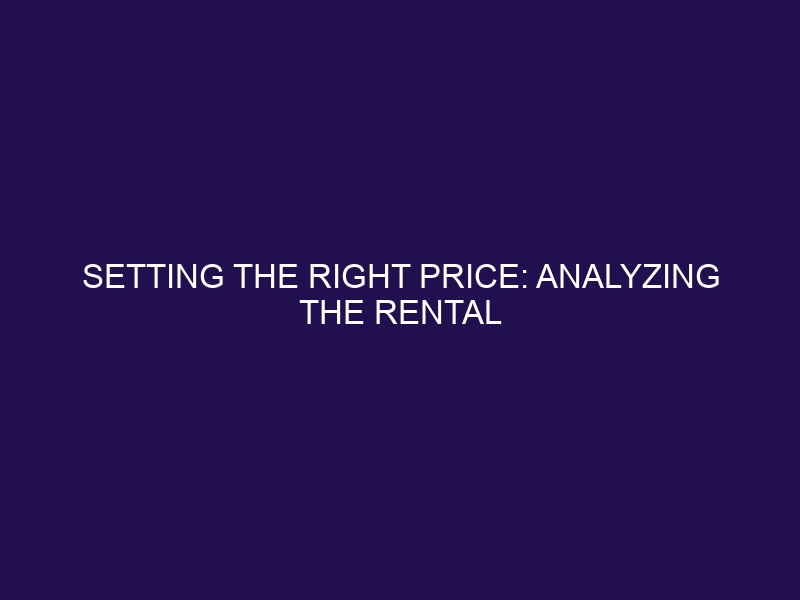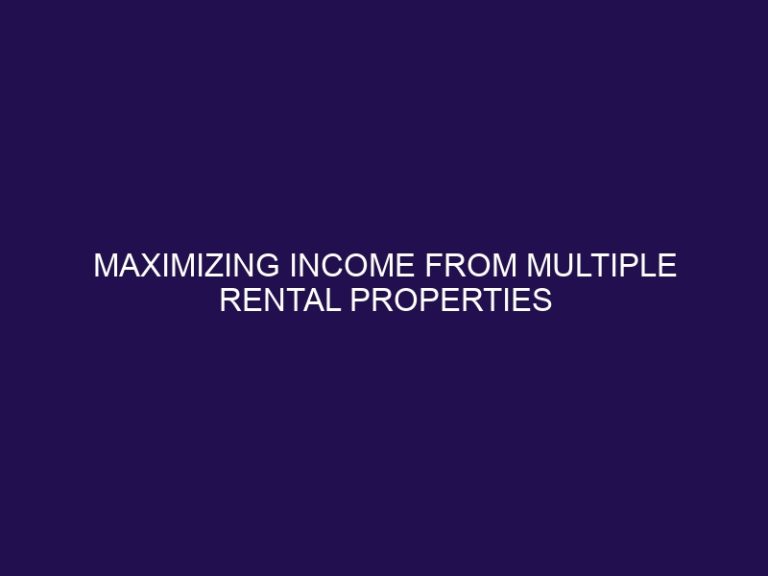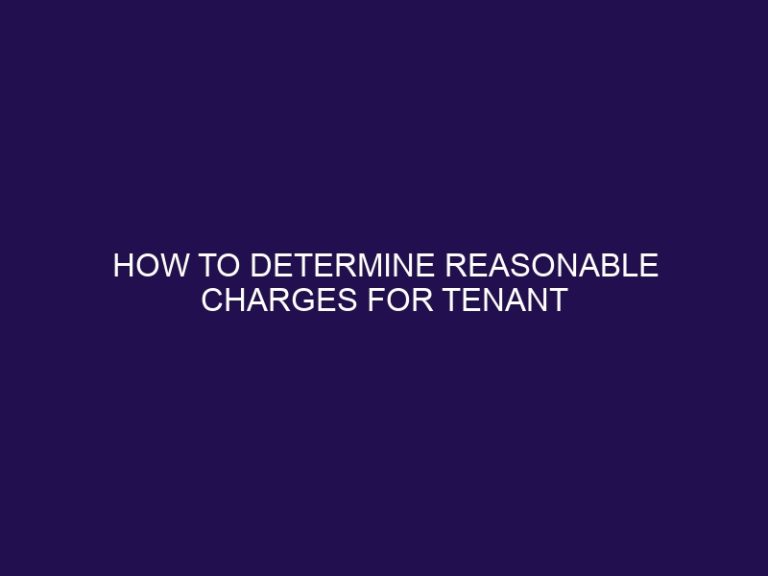Setting the Right Price: Analyzing the Rental Market
The rental market refers to the market for rental properties, where landlords and tenants engage in a contract for the use of a property in exchange for a set amount of rent. The rental market is a vital component of the real estate industry and is influenced by various factors that determine the prices for rental properties.
Some of the key factors that affect rental prices include:
- the location of the property
- the type of property
- the amenities and features offered
- the demand and supply in the market
- and the overall economic conditions
According to a research paper published by the Journal of Property Management, these factors have a significant impact on rental prices, with location being the primary determinant.
To set the right price for your rental property, it is crucial to carefully analyze these factors and consider your expenses and desired profit. Conducting thorough research on comparable properties and understanding the local market trends can also help in determining the right price.
There are different pricing strategies that landlords can use for their rental properties, such as:
- market-based pricing, which involves setting the rent based on the prevailing market rates
- cost-based pricing, which considers the expenses incurred by the landlord in maintaining the property
- and value-based pricing, which takes into account the value and benefits that the property offers to the tenant
Some common mistakes to avoid when setting rental prices include overpricing, which can make the property less appealing to potential tenants, and underpricing, which can result in a loss of potential profits. Landlords should also not overlook market trends and expenses when setting prices.
In a changing market, it may be necessary to adjust rental prices to stay competitive and attract tenants. Landlords can do this by regularly monitoring market trends, offering incentives such as discounted rent or free utilities, being flexible with lease terms, and seeking advice from a professional. By carefully analyzing the rental market and making informed pricing decisions, landlords can ensure the profitability and success of their rental properties.
What is the Rental Market?
The rental market is the sector in which individuals or businesses lease properties, including apartments, houses, or commercial spaces, in exchange for payment. It involves the interactions between supply and demand, rental rates, and property management in a specific geographical area.
What Factors Affect Rental Prices?
When it comes to setting the right price for a rental property, there are a multitude of factors to consider. These factors can greatly influence the rental prices in a particular market and understanding them is key to making an informed decision. In this section, we will explore the various factors that can affect rental prices, including the location of the property, the type of property, the amenities and features it offers, the current demand and supply in the market, and the overall economic conditions. By understanding these factors, landlords and property owners can make strategic pricing decisions to maximize their profits.
1. Location
- Evaluate the neighborhood’s safety and amenities.
- Analyze proximity to public transport, schools, and workplaces.
- Assess the desirability of the location based on local demand.
2. Property Type
The type of property has a significant impact on rental prices. For example, apartments located in prime areas typically have higher rents compared to single-family homes. Other factors such as size, layout, and amenities also play a role in determining the price. It is important to consider these aspects when setting rental rates for different types of properties.
3. Amenities and Features
Amenities and features, such as a gym, pool, or in-unit laundry, have a significant impact on rental prices. Properties that offer these extras can demand higher rents, especially in competitive markets. For example, apartments with a balcony may see a 5-10% premium on rent compared to those without.
4. Demand and Supply
The interplay of demand and supply plays a crucial role in determining rental prices. When demand is high and properties are limited, prices tend to increase. On the other hand, an oversupply of properties can lead to a decrease in prices. This was evident in the rental market crash of 1986, where an oversupply of properties caused a sharp decline in prices, affecting property owners across the nation.
5. Economic Conditions
- Keep an eye on economic indicators such as inflation, employment rates, and GDP growth.
- Evaluate the effects of economic fluctuations on rental demand and the affordability of tenants.
- Modify rental prices in accordance with economic shifts to stay competitive and accommodate tenants.
Did you know? Economic recessions can result in a higher demand for rental properties as people choose to rent instead of buying a home.
How to Determine the Right Price for Your Rental Property?
As a landlord, one of the most important decisions you will make is determining the right price for your rental property. This can be a tricky task, as you want to find a balance between making a profit and attracting potential tenants. In this section, we will delve into the key factors that go into determining the right price for your rental property. From researching comparable properties to understanding the local market trends, we will cover all the essential steps to help you set the perfect price for your rental.
1. Research Comparable Properties
- Use online real estate platforms to gather data on similar properties in your area.
- Compare factors like location, size, amenities, and condition to determine a competitive rental price.
- Consider hiring a professional appraiser for accurate insights.
Once, a friend found the perfect rental price by researching comparable properties and ended up attracting quality tenants.
2. Consider Your Expenses and Desired Profit
- Assess all property expenses, including mortgage, maintenance, and taxes.
- Determine the desired profit margin based on investment goals.
- Analyze the local rental market to understand competitive pricing and consider your expenses and desired profit.
3. Understand the Local Market Trends
To understand the local market trends, begin by analyzing rental listings, vacancy rates, and rent prices in your area.
Gain insights into the current market conditions by consulting with local real estate agents or property managers.
Track rental price fluctuations and demand patterns by utilizing online resources and historical data.
In 2019, it was evident that there was a rising demand for studio apartments, which resulted in a 10% increase in rental prices within the downtown area.
4. Analyze Your Target Audience
- Identify demographics – age, income, and family size – of your target audience.
- Understand their lifestyle preferences, including whether they prefer urban or suburban areas, if they are pet-friendly, and what amenities they value.
- Analyze the rental history of your target audience, including past tenants, length of stay, and reasons for leaving.
What are the Different Pricing Strategies for Rental Properties?
When it comes to setting the right price for your rental property, there are several strategies that landlords can utilize. In this section, we will discuss the various pricing strategies commonly used in the rental market. From market-based pricing, which takes into account the current demand and supply in the area, to cost-based pricing, which factors in the expenses of maintaining the property, and value-based pricing, which considers the unique features and benefits of the rental unit. Each strategy has its own advantages and considerations, and understanding them can help landlords make informed decisions about their rental prices.
1. Market-based Pricing
- Research: Evaluate similar properties to set market-based rates.
- Compare: Analyze location, amenities, and demand for accurate pricing.
- Adjust: Align rates with market fluctuations to stay competitive.
2. Cost-based Pricing
- Evaluate the direct costs associated with the rental property, including property taxes, insurance, and maintenance.
- Factor in indirect costs such as mortgage interest, depreciation, and property management fees, when using cost-based pricing.
- Add a desired profit margin to cover investment returns and risks when implementing this pricing strategy.
3. Value-based Pricing
- Recognize the distinct value that your rental property provides.
- Evaluate the demand for comparable properties and their pricing.
- Emphasize unique features and amenities to justify the value.
- Adapt pricing based on the perceived value by the target audience.
What are the Common Mistakes in Setting Rental Prices?
When it comes to setting rental prices, there are several factors to consider in order to ensure profitability and competitiveness in the market. However, many landlords and property owners make common mistakes that can ultimately hurt their bottom line. In this section, we will discuss the most common mistakes in setting rental prices, including overpricing, underpricing, neglecting market trends, and ignoring expenses and profit goals. By understanding these mistakes, you can avoid them and set the right price for your rental property.
1. Overpricing
- Assess similar properties in the area to understand their pricing and avoid overpricing.
- Consider amenities and features offered by competitive rentals to ensure your rental is priced competitively.
- Consult with local real estate professionals to gain insights on market trends and avoid setting an unreasonably high price.
- Ensure the pricing aligns with the demand in the rental market to attract potential tenants.
2. Underpricing
Underpricing rental properties can result in missed revenue opportunities, attracting low-quality tenants, and undervaluing your property. To prevent underpricing, it is important to conduct comprehensive market research, analyze similar properties, and consider all of the amenities and features that your property has to offer.
3. Neglecting Market Trends
- Regular Monitoring: Stay updated on rental market shifts and adjust prices accordingly.
- Utilize Professional Insights: Seek guidance from local real estate professionals to accurately interpret market trends.
- Implement Flexibility: Be open to modifying prices to align with current demand and supply dynamics and avoid neglecting market trends.
4. Ignoring Expenses and Profit Goals
Neglecting expenses and profit goals when determining rental prices can have negative financial consequences. It is crucial to consider all costs, such as maintenance, utilities, and mortgage, in order to achieve profitability. Having a clear understanding of the desired profit margin is vital for maintaining sustainable property management.
How to Adjust Rental Prices in a Changing Market?
In the competitive rental market, setting the right price is crucial for attracting potential tenants and maximizing profits. However, market conditions are constantly changing, making it necessary for landlords and property managers to regularly adjust their rental prices. In this section, we will discuss the key strategies for adapting to a changing market. From monitoring market trends to offering incentives and being flexible with pricing, these techniques will help you maintain a competitive edge and ensure the success of your rental business.
1. Monitor Market Trends Regularly
- Set up automated alerts for rental listings and prices in your area.
- Track changes in rental demand and supply through real estate websites and local agencies.
- Regularly review economic indicators that can influence rental market dynamics and monitor market trends.
2. Consider Offering Incentives
- Evaluate the current market demand and competition.
- Consider offering move-in specials or discounts on the first month’s rent.
- Provide incentives such as free parking, gym membership, or utilities.
- Consider offering lease renewal bonuses or referral rewards for tenants.
3. Be Flexible with
- Monitor market trends regularly.
- Consider offering incentives.
- Be Flexible with lease terms and negotiation.
- Adjust prices based on demand and competition.
Being Flexible with rental prices allows landlords to adapt to market changes and attract quality tenants.
Frequently Asked Questions
What is rental market analysis and why is it important for rental property owners?
Rental market analysis (RMA) is a process of conducting in-depth research and analysis of the local real estate market to evaluate the potential profitability of rental investments. It takes into account factors like property prices, competition, rental rates, demand, occupancy, cap rate, and cash on cash return. RMA is crucial for rental property owners as it provides valuable insights into the rental market and helps make informed decisions for optimizing occupancy, setting competitive rental rates, and achieving financial goals.
What are the key steps involved in conducting an accurate rental market analysis?
There are six steps to conducting an accurate rental market analysis: 1) Identifying the specific area or zip code to focus on, 2) Gathering data on property prices and rental rates, 3) Analyzing historical trends and future rental market forecasts, 4) Calculating formulas like cap rate and cash on cash return, 5) Assessing the competition and property features, and 6) Making informed decisions for setting the right price and attracting tenants.
What factors should aspiring traditional landlords consider before buying an investment property?
For aspiring traditional landlords, location is a crucial factor in making successful real estate investments. They should conduct proper research on the rental potential of the area, considering factors like demand, competition, local amenities, rent control laws, and rental market trends. It’s also essential to consider the property’s appeal, operational costs, and potential for attractive rental income.
How can rental market analysis help Airbnb hosts in setting up and optimizing their rental units?
Rental market analysis can be a valuable tool for Airbnb hosts, as it provides a detailed assessment of the local real estate market and the performance of income properties. It helps in setting competitive rental rates, identifying the highest potential for profitable investments, and understanding the steady cash flow projections. RMA can also assist in making sound investment decisions for potential property purchases and lease renewals.
What are the benefits of using Mashvisor tools for rental market analysis?
Mashvisor tools are the best tools for conducting accurate rental market analysis and saving time for real estate investors. These tools provide crucial indicators for investment viability assessments, valuable insights into the local real estate market trends, and the performance of comparable rental properties. They also offer extensive data on property prices, competition, rental rates, demand, and occupancy, making it easier to make informed decisions for setting the right price and attracting tenants.
How can rental market analysis help in setting the right price for a rental property?
Rental market analysis can be a primary source of information for setting the right price for a rental property. It provides detailed insights into the local real estate market and the performance of comparable rental properties, allowing property owners to determine the average rental rates and the highest potential for rental income. By considering factors like property features, competition, and the cost of owning and maintaining the property, RMA can help rental property owners avoid leaving money on the table and ensure positive cash flow and steady income on a monthly basis.







